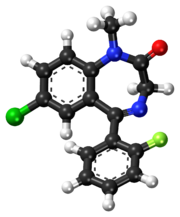|
Fludiazepam
Alerta sobre risco à saúde
|

|

|
| Nome IUPAC
|
7-chloro-5-(2-fluorophenyl)-1-methyl-1,3-dihydro-2H-1,4-benzodiazepin-2-one
|
| Identificadores
|
| Número CAS
|
3900-31-0
|
| PubChem
|
3369
|
| DrugBank
|
DB01567
|
| ChemSpider
|
3252
|
| ChEBI
|
31618
|
| Código ATC
|
N05BA17
|
| SMILES
|
- O=C1CN=C(C2=CC=CC=C2F)C3=CC(Cl)=CC=C3N1C
|
| Primeiro nome comercial ou de referência
|
Erispan (Japão, Taiwan)
|
| Propriedades
|
| Fórmula química
|
C16H12ClFN2O
|
| Massa molar
|
302.73 g mol-1
|
| Farmacologia
|
| Metabolismo
|
Hepático
|
| Excreção
|
Renal
|
| Página de dados suplementares
|
| Estrutura e propriedades
|
n, εr, etc.
|
| Dados termodinâmicos
|
Phase behaviour
Solid, liquid, gas
|
| Dados espectrais
|
UV, IV, RMN, EM
|
Exceto onde denotado, os dados referem-se a
materiais sob condições normais de temperatura e pressão
Referências e avisos gerais sobre esta caixa.
Alerta sobre risco à saúde.
|
Fludiazepam,[1] comercializado sob o nome de Erispan (エリスパン)[2][3] é uma benzodiazepina potente derivada do 2ʹ-fluoro do diazepam,[4] originalmente desenvolvido por Hoffman-La Roche na década de 1960.[5] É comercializado no Japão e em Taiwan. Ele exerce suas propriedades farmacológicas através do aumento da inibição GABAérgica.[6] O fludiazepam tem 4 vezes mais afinidade de ligação com os receptores GABA que o diazepam.[7] Possui propriedades ansiolíticas,[8][9][10] anticonvulsivantes, sedativas, hipnóticas e relaxantes musculoesqueléticas.[11] O fludiazepam tem sido usado recreacionalmente.[12]
Ver também
Referências
- ↑ US Patent 3371085 5-aryl-3h-1,4-benzodiazepin-2(1h)-ones
- ↑ Su TP, Chen TJ, Hwang SJ, Chou LF, Fan AP, Chen YC. «Utilization of psychotropic drugs in Taiwan: an overview of outpatient sector in 2000». Zhonghua Yi Xue Za Zhi (Chinese Medical Journal; Free China ed). 65: 378–91. PMID 12455808
- ↑ «Benzodiazepine Names». non-benzodiazepines.org.uk. Consultado em 29 de dezembro de 2008. Cópia arquivada em 8 de dezembro de 2008
- ↑ Neville GA, Beckstead HD, Shurvell HF. «A Fourier transform-Raman and infrared vibrational study of delorazepam, fludiazepam, flurazepam, and tetrazepam». Journal of Pharmaceutical Sciences. 83: 143–51. PMID 7909552. doi:10.1002/jps.2600830207
- ↑ US Patent 3299053 -ARYL-JH-L,X-BENZODIAZEPIN-Z(LH)-ONES
- ↑ Tsuchiya T, Fukushima H. «Effects of benzodiazepines and pentobarbitone on the gaba-ergic recurrent inhibition of hippocampal neurons». European Journal of Pharmacology. 48: 421–4. PMID 648585. doi:10.1016/0014-2999(78)90169-3
- ↑ Nakatsuka I, Shimizu H, Asami Y, Katoh T, Hirose A, Yoshitake A. «Benzodiazepines and their metabolites: relationship between binding affinity to the benzodiazepine receptor and pharmacological activity». Life Sciences. 36: 113–9. PMID 2857046. doi:10.1016/0024-3205(85)90089-X
- ↑ Okada S, Ichiki K, Tanokuchi S, Ishii K, Hamada H, Ota Z (1994). «Effect of an anxiolytic on lipid profile in non-insulin-dependent diabetes mellitus». The Journal of International Medical Research. 22: 338–42. PMID 7895897. doi:10.1177/030006059402200605
- ↑ Okada S, Ichiki K, Tanokuchi S, Ishii K, Hamada H, Ota Z (1995). «Improvement of stress reduces glycosylated haemoglobin levels in patients with type 2 diabetes». The Journal of International Medical Research. 23: 119–22. PMID 7601294. doi:10.1177/030006059502300205
- ↑ Okada S, Ichiki K, Tanokuchi S, Ishii K, Hamada H, Ota Z (1995). «How blood pressure in patients with non-insulin-dependent diabetes mellitus is influenced by stress». The Journal of International Medical Research. 23: 377–80. PMID 8529781. doi:10.1177/030006059502300508
- ↑ Inoue H, Maeno Y, Iwasa M, Matoba R, Nagao M. «Screening and determination of benzodiazepines in whole blood using solid-phase extraction and gas chromatography/mass spectrometry». Forensic Science International. 113: 367–73. PMID 10978650. doi:10.1016/S0379-0738(00)00226-7
- ↑ Shimamine M, Masunari T, Nakahara Y (1993). «[Studies on identification of drugs of abuse by diode array detection. I. Screening-test and identification of benzodiazepines by HPLC-DAD with ICOS software system]». Eisei Shikenjo Hokoku. Bulletin of National Institute of Hygienic Sciences: 47–56. PMID 7920567
|

